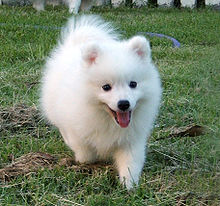日本スピッツ (Japanese Spitz)

The Japanese Spitz (日本スピッツ Nihon Supittsu?) is a small to medium breed of dog of the Spitz type. The Japanese Spitz is a companion dog and pet. There are varying standards around the world as to the ideal size of the breed, but they are always larger than their smaller cousins, the Pomeranian. They were developed in Japan in the 1920s and 30s by breeding a number of other Spitz type dog breeds together. They are recognized by the vast majority of the major kennel clubs, except the American Kennel Club due to it being similar appearance to the white Pomeranian dog, American Eskimo Dog and Samoyed Dog. While they are a relatively new breed, they are becoming widely popular due to their favorable temperament and other features.
The major health concern is patellar luxation, and a minor recurring concern is that the breed can be prone to runny eyes. They can act as reliable watchdogs, but are a type of companion dog and prefer to be an active part of the family. Although they might appear fluffy, they are a low maintenance breed as dirt does not stick to the coat.
Appearance
The Japanese Spitz is a small dog, around 33 cm (13 ins) at the withers, with a somewhat square body, deep chest, and a very thick, pure white double coat. The coat consists of an outer coat that stands off from the soft inner coat, with fur shorter on the muzzle and ears as well as the fronts of the forelegs and the hindlegs. A ruff of longer fur is around the dog's neck. It has a pointed muzzle and small, triangular shape prick ears (ears that stand up.) The tail is long, heavily covered with long fur, and is carried curled over and lying on the dog's back. The white coat contrasts with the black pads and nails of the feet, the black nose, and the dark eyes.The large oval (akin to a ginko seed) eyes are dark and slightly slanted with white eyelashes, and the nose and lips and eye rims are black. The face of the Japanese Spitz is wedge-shaped.
They share a common resemblance with the white Pomeranian dog, Samoyed and American Eskimo Dog.
Health
They are a healthy breed with very few genetic problems. The main health concern for Japanese Spitz is the development of Patellar luxation, a condition in which the kneecap dislocates out of its normal position. They can also be prone to runny eyes, which is most commonly due to having tear ducts that are too small, or an allergy to long grass or stress. It is rarely caused by any serious eye defect.
Temperament
Active, loyal, and bright, the Japanese Spitz are known for their great courage, affection and devotion making them great watchdogs and ideal companions for older people and small children. Most Japanese Spitz are good watch dogs, despite their relatively small size, and they have a tendency to bark to warn of arriving strangers. The Japanese Spitz is first and foremost a companion dog and thrives on human contact and attention, preferring to be a member of the family. They are known as very loyal dogs. They enjoy being active and love to be in the outdoors. They are intelligent, playful, alert, and obedient, and particularly excellent and loving toward children.Unlike many other dogs, the Japanese Spitz will customarily have his or her tail flipped onto its back. In some cases this is thought dominant behaviour, but in the Japanese Spitz case this is normal bearing.
Care
Japanese Spitz can tolerate cold weather but, as it was bred as a companion dog, prefers to live in the house with the warmth of its human family.Though they can live in apartments, they need ample time running around outside off-leash in a safe environment.
Grooming
Despite the appearance of the Japanese Spitz’s pure white coat, they are in fact a low-maintenance breed. They are very clean dogs and do not have the common "doggy odour" that many other breeds have. Due to the texture of their coat, mud and dirt falls off or can be brushed out very easily. However, due to the breed's thick coat, regular brushing is essential.They blow their coats once a year, but like most dogs shed minimally all year round.
Some love to swim, and this can render regular baths unnecessary.
The Japanese Spitz's coat is relatively dry compared to other breeds. Some sources state that the breed should not be bathed more frequently than once every two months, as bathing and shampoo strips the natural oil and moisture from their coat.This can cause skin sensitivity and itchiness. Their coat should be groomed twice a week using a pin brush that reaches to the undercoat, preventing formation of knots. Grooming this breed is relatively easy in contrast to other dog breeds. Their white fur coat has a non-stick texture often described as being similar to Teflon.

How to make money from gambling.com
ReplyDeleteBet on sports with Betfair Sportsbook. The odds on your favourite sport are the หาเงินออนไลน์ same, so make sure 인카지노 to take advantage of the welcome offers and offers. 바카라사이트